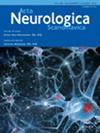Perampanel单药治疗局灶性和全身性癫痫的临床实践
IF 2.9
3区 医学
Q2 CLINICAL NEUROLOGY
引用次数: 0
摘要
目标。利用PERMIT研究的数据,研究perampanel (PER)在日常临床实践中作为单一疗法治疗局灶性或全面性癫痫的有效性、安全性和耐受性。方法。PERMIT是对来自17个国家的44项现实世界研究的汇总分析,在这些研究中,局灶性和全面性癫痫患者接受PER治疗。这项事后分析包括在基线时接受PER单药治疗的来自PERMIT的癫痫患者(PWE)。3个月、6个月和12个月后分别评估保留率和有效性。有效性评估包括≥50%的应答率和癫痫发作自由率(至少自上次就诊以来未发生癫痫发作)。通过评估不良事件(ae)和因ae而停药来评估安全性和耐受性。结果。总的来说,268名PWE在基线时接受了PER单药治疗。对168 PWE进行保留评估,183 PWE进行有效性评估,197 PWE进行安全性和耐受性评估。3个月、6个月和12个月的留存率分别为91.1%、87.3%和73.3%。12个月时,总体应答率为84.2%,基线时仅局灶性癫痫发作的PWE应答率为82.9%,基线时仅全面性癫痫发作的PWE应答率为88.0%;相应的自由率分别为62.9%、57.7%和80.0%。45.2%的PWE患者报告ae。最常见的ae(≥5%的PWE)是头晕/眩晕(16.8%)、易怒(11.2%)、嗜睡(9.1%)和抑郁(6.6%)。在12个月的时间里,13.7%的患者因ae而停药。结论。在临床实践中,PER作为单药治疗是有效的,特别是对于那些有全身性癫痫发作的患者,并且通常耐受性良好。本文章由计算机程序翻译,如有差异,请以英文原文为准。
Perampanel Monotherapy for Focal and Generalized Epilepsy in Clinical Practice
Objectives. To investigate the effectiveness, safety, and tolerability of perampanel (PER) when used as monotherapy to treat focal or generalized epilepsy in everyday clinical practice, using data from the PERMIT study. Methods. PERMIT was a pooled analysis of 44 real-world studies from 17 countries, in which people with focal and generalized epilepsy were treated with PER. This post hoc analysis included people with epilepsy (PWE) from PERMIT who were treated with PER monotherapy at baseline. Retention and effectiveness were assessed after 3, 6, and 12 months. Effectiveness assessments included ≥50% responder rate and seizure freedom rate (no seizures since at least the prior visit). Safety and tolerability were assessed by evaluating adverse events (AEs) and discontinuation due to AEs. Results. Overall, 268 PWE were treated with PER monotherapy at baseline. Retention was assessed for 168 PWE, effectiveness for 183 PWE, and safety and tolerability for 197 PWE. Retention rates were 91.1%, 87.3%, and 73.3% at 3, 6, and 12 months, respectively. At 12 months, responder rates were 84.2% overall, 82.9% in PWE with only focal-onset seizures at baseline, and 88.0% in those with only generalized-onset seizures at baseline; corresponding freedom rates were 62.9%, 57.7%, and 80.0%, respectively. AEs were reported for 45.2% of PWE. The most frequently reported AEs (≥5% of PWE) were dizziness/vertigo (16.8%), irritability (11.2%), somnolence (9.1%), and depression (6.6%). Over 12 months, 13.7% discontinued due to AEs. Conclusions. PER was effective when used as monotherapy in clinical practice, particularly in those with generalized-onset seizures, and was generally well tolerated.
求助全文
通过发布文献求助,成功后即可免费获取论文全文。
去求助
来源期刊

Acta Neurologica Scandinavica
医学-临床神经学
CiteScore
6.70
自引率
2.90%
发文量
161
审稿时长
4-8 weeks
期刊介绍:
Acta Neurologica Scandinavica aims to publish manuscripts of a high scientific quality representing original clinical, diagnostic or experimental work in neuroscience. The journal''s scope is to act as an international forum for the dissemination of information advancing the science or practice of this subject area. Papers in English will be welcomed, especially those which bring new knowledge and observations from the application of therapies or techniques in the combating of a broad spectrum of neurological disease and neurodegenerative disorders. Relevant articles on the basic neurosciences will be published where they extend present understanding of such disorders. Priority will be given to review of topical subjects. Papers requiring rapid publication because of their significance and timeliness will be included as ''Clinical commentaries'' not exceeding two printed pages, as will ''Clinical commentaries'' of sufficient general interest. Debate within the speciality is encouraged in the form of ''Letters to the editor''. All submitted manuscripts falling within the overall scope of the journal will be assessed by suitably qualified referees.
 求助内容:
求助内容: 应助结果提醒方式:
应助结果提醒方式:


